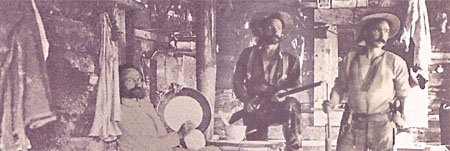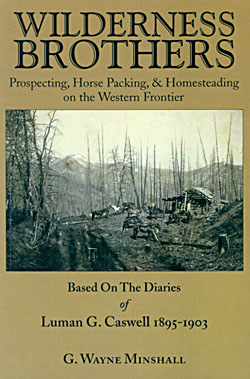Wilderness Brothers: Prospecting, Horse Packing & Homesteading on the Western Frontier. By G. Wayne Minshall. Streamside Scribe Press, Inkom, ID. ISBN 9780984949007 (Amazon.com: More Information or Purchase)
This an outstanding historical work - one of the best I've come across - which truly captures what it was like forging a homestead in the wilderness. The gist of it? It wasn't easy being a homesteader. It was a lot of sweat and hard labor. But it took more than sheer physical effort. It took intelligence, cleverness, skill and inventiveness. And then it took more sweat and blood and backbreaking work.
What makes this book so compelling is its authenticity, the way in which author G. Wayne Minshall has developed the story, rigorously maintaining a true-life accuracy, and in doing so, bringing historical characters alive.
The book centers on the diaries of Luman Caswell. In the late 1800’s, Caswell along with his brother, take a 2,500-mile journey by buckboard wagon and horseback, eventually settling along Big Creek deep in the mountainous wilderness of central Idaho. It is, in fact, still wilderness to this day. Big Creek is a part of the Frank Church River of No Return Wilderness, one of the largest wilderness in the lower 48 - where, it so happens, Minshall has spent many years as a research biologist.
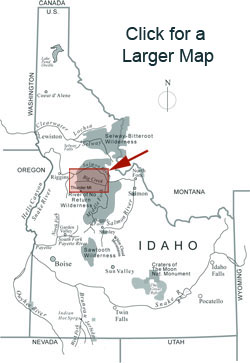 There's much more here than homesteading. In the wilderness, a day or two journey from their small ranch, Caswell and his brothers, in time, discover enough gold that they set off what would become one of the last great American gold rushes: the Thunder Mountain rush.
There's much more here than homesteading. In the wilderness, a day or two journey from their small ranch, Caswell and his brothers, in time, discover enough gold that they set off what would become one of the last great American gold rushes: the Thunder Mountain rush.
In the telling of Caswell's story, you can almost imagine Minshall on one of his research trips, through some sort of strange twist of time, meeting an old character deep in that wilderness. They share a campsite, and Caswell launches into his story which keeps Minshall mesmerized late into the night.
Minshall re-tells that story to us. He narrates the saga of that old character - and what a saga it is! By quoting and often summarizing diary entries, he keeps things moving along, providing his readers with perspective and background, but he never intrudes, never upstages his protagonist. You feel that you're there with Caswell, amidst the pines and open hillsides rising above Big Creek.
Several years before their major gold discovery and their first year in the wilderness, the Caswell brothers established a winter ranch on Big Creek. (A third brother later joined them.) The cabin was hastily constructed out of logs and chinked with mud, but as Minshall writes "it got them through the first winter."
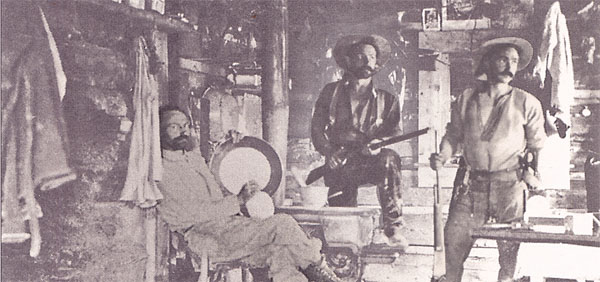
The Caswell Brothers at their Thunder Mountain Cabin. Photo Credit: Idaho Historical Society
The next year, they moved to a new location across Big Creek and established a main cabin and several other buildings. All the work was done by hand. Logs for the cabin were cut and dragged to the cabin site by horses. Planks for flooring, roofing, tables and beds were cut in a pit using a large saw known as a whipsaw: one person worked below in the pit on one end of the saw and the other on top, alternating pulling and pushing, sawing endlessly all day.
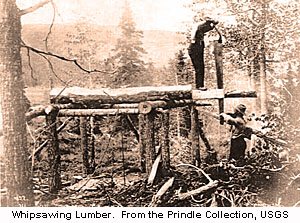 In a later chapter, Minshall describes whipsawing in more detail: "Over the next day, Lu [Luman] and an unknown partner saw out lumber including 152' on the 15th, 290' on the 16th, 230' on the 20th." This went on, and then upon concluding the work, Caswell writes in his own succinct style: "Finished sawing 1230 feet of boards." Over a thousand board feet! It's an utterly astonishing amount of work, demanding an almost inhuman effort. Yet Caswell mentions it as casually as he might mention tying his shoes.
In a later chapter, Minshall describes whipsawing in more detail: "Over the next day, Lu [Luman] and an unknown partner saw out lumber including 152' on the 15th, 290' on the 16th, 230' on the 20th." This went on, and then upon concluding the work, Caswell writes in his own succinct style: "Finished sawing 1230 feet of boards." Over a thousand board feet! It's an utterly astonishing amount of work, demanding an almost inhuman effort. Yet Caswell mentions it as casually as he might mention tying his shoes.
The variety and number of chores accomplished in one day is bewildering. Minshall elaborates their undertakings in late 1896: "November and December are spent hunting, trapping and cutting wood, and doing a variety of lesser tasks; for example mending shoes, sighting in guns, loading cartridges, and making moccasins, shakes [shingles for the roof], tubs and a drawing knife." 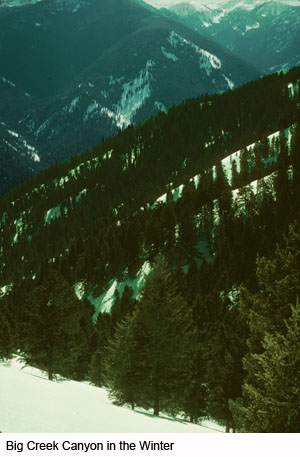 They grade a primitive wagon road on their homestead (all by hand and horse power) and then proceed to build a bridge over the creek. Amongst all this, they prepare their own meals - and even manage to turn out a few treats: "On December 30th," Minshall writes, "Lu makes some pies and cakes to close out the year."
They grade a primitive wagon road on their homestead (all by hand and horse power) and then proceed to build a bridge over the creek. Amongst all this, they prepare their own meals - and even manage to turn out a few treats: "On December 30th," Minshall writes, "Lu makes some pies and cakes to close out the year."
As the season progressed into the dead of winter, the work never stopped. The idea that wilderness pioneers like the Caswells settled back in front of pot belly stoves and read books all winter is pure fable. The same sort of exhausting schedule was kept up throughout the winter.
Then finally as the snow melted and the trails become passable, they continued prospecting. They had already found "color" in the Thunder Mountain area high on one of the tributaries of Big Creek - that was the impetus for their homestead - but each summer, they filed more claims, worked existing ones and continued seeking out a larger find.
Finally in 1901, with gold assaying out in promising amounts, they sold several of their claims to a group of investors. The news of the sale set off a stampede of thousands to Thunder Mountain: starry-eyed prospectors, merchants, speculators and schemers of all stripes. In the midst of the wilderness along Monumental Creek, the town of Roosevelt sprang up.
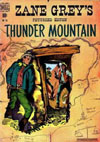 But it was all short lived. The gold petered out quickly, and it all came to a dramatic end in 1909 when a massive mudslide dammed Monumental Creek, its rising waters drowning and completely covering the town of Roosevelt. It is a fascinating part of western history and lore, and the watery demise of Roosevelt and the Thunder Mountain gold rush were amply romanticized in a Zane Grey novel.
But it was all short lived. The gold petered out quickly, and it all came to a dramatic end in 1909 when a massive mudslide dammed Monumental Creek, its rising waters drowning and completely covering the town of Roosevelt. It is a fascinating part of western history and lore, and the watery demise of Roosevelt and the Thunder Mountain gold rush were amply romanticized in a Zane Grey novel.
But fictional accounts aside, the true story of the Caswells is far more fascinating. The brothers became relatively wealthy by the standards of the time and eventually left the wilderness. Minshall follows their winding trail once back in civilization: courtships, marriages, families, homes in the city, business endeavors. Eventually a shadow is cast over their fortunes - in one case by their own undoing, and in another, by just plain bad luck.
What happened? I could say, but Minshall says it infinitely better. For that reason and others, you’ll want to pick up a copy of the book. Then take a marvelous journey back in time.
Amazon.com: More Information or Purchase
Other Links: Streamside Scribe Press Website
________
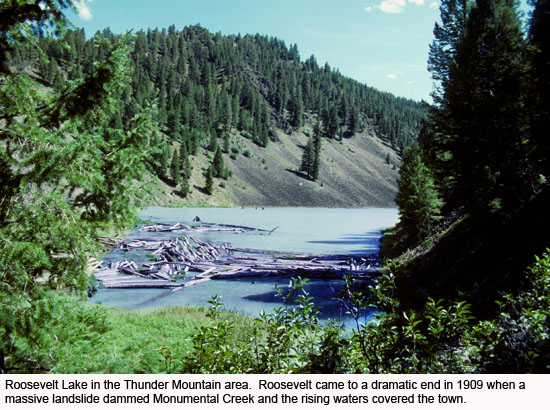
[End of Review]

